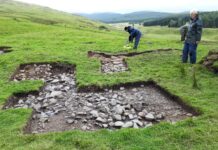Three new reports are now available for sites 110, 111 and 126. These sites are all similar stone setting sites found during the survey and excavation as part of the Daer Valley project. Suspected to be Bronze Age and potential funerary structures, however there is little evidence to prove this. We discuss this in each of the reports below. All excavation and survey information and images are freely available. Get in touch if you would like more information. A full project report is in progress – in the meantime the interim reports Daer First Results 2011 and Daer Lithics Report are currently available to view.

Daer Valley Project Report Site 110 – Tam Ward
Site 110 lies on the southern flank of Coom Rig and is at the base of a break of slope leading up hill and just above a less acute break of slope downhill, however the site itself lies on natural sloping ground of about 0.5m. The site was initially seen as boulders and smaller stones disturbed across three furrows, the stones were thought to be from small cairns. Download the PDF (1.5MB) to read more.

Daer Valley Project Report Site 111– Tam Ward
The location of this site was first thought to be a group of small cairns dispersed over at least three furrows and disturbed by the forest plough. Stones were evidently disturbed in the furrows but none were visible on the baulks between. The site lies roughly half way down on the southern flank of Coom Rig, and at the base of a break in slope and is on a gentle slope itself, dropping for about a metre from top to bottom in the excavated trench. The area upon which the sit lies is the eastern end of a natural terrace, the western end of the same terrace is occupied by Site No 126. Download the PDF (2.3MB) to read more.

Daer Valley Project Report Site 126 – Tam Ward
The site was discovered like several others by the presence of large stones lying in the furrow. In this case they were considered unlikely to be the remains of a cairn and indeed they were suspected as being similar in nature to Sites’ 111 and 110, both lying to the east, and to an extent this was shown to be the case. Download the PDF (1.8MB) to read more.












